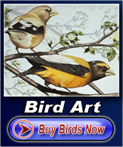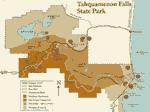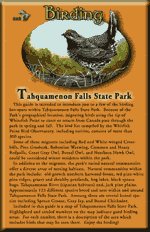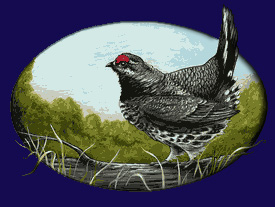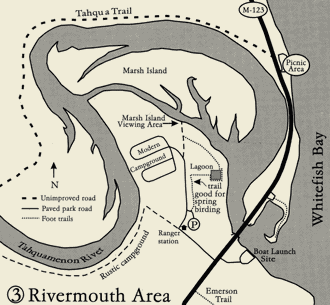|
|
|
|
|
|
|
|
|
|
|
|
Tahquamenon Falls State Park
is documenting nesting species; please contact the park headquarters with information about birds you found on nests or with young while visiting the Park.
Please contact
Jon Spieles at:
(906) 492-3415 or email at spielesj@michigan.gov for birding and moose info.
Spruce Grouse cover art by Bird artist Gina Harman
Information on birding compiled by:
Jodi Spieles and Jon Spieles
|
|
|
|
|
|
|
|
|
|
|
|
|
|
|
|
|
|
|
|
Tahquamenon Falls State Park Birding
Tahquamenon Falls State Park, nearly 40,000 acres in size, is one of Michigan's most unique birding locations.
|
|
Migrating birds using Whitefish Point to enter or return from Canada, pass through the park every spring and fall. More than 300 species, including the rarities, have been documented using this migration corridor.
The park also provides exciting birding during the breeding season. A variety of natural communities including, old-growth hardwood forests, red pine/white pine ridges, jack pine plains, grass and shrub peatlands, and black spruce bogs offer nesting habitat for approximately 125 species. Among these are several boreal species including spruce grouse, gray jay, black-backed woodpecker and boreal chickadee.
|
|
|
Birding within the Tahquamenon Falls State Park
|
|
|
1) Lone Pine Access Site
Wetlands in the area offer outstanding opportunities to view spring and fall migration; particularly during periods of poor weather. Look for waterfowl and shorebirds in the roadside ditches and on Tahquamenon Bay. Sedge wren. Lincoln's sparrow, song sparrow, LeConte's sparrow, northern harrier, bald eagle, and merlin are among the species seen here throughout the summer. Michigan's only recorded Wilson's warbler nest was found here in 1988. Bohenian waxwings can be seen feeding on rose hips and Michigan holly in the fall. From the end of the access road, overlooking Tahquamenon Bay, you can see Emerson Island. The island was the site of a large sawmill from 1887 to 1910.
2) Emerson Foot Trail
This trail passes through black spruce and spruce and shrub swamp following the road that leads to the abandoned sawmill town of Emerson. The last 1/4 mile is not completely cleared, but you may follow this trail to Whitefish Bay. The trail is one mile (one way) and may have standing water during wet periods. Trail edges come alive with sparrows and warblers during spring and fall migration. Species common to this area during the summer include, ruffed grouse, American woodcock, yellow-bellied flycatcher, white throated-sparrow, and ruby-crowned kinglet. Boreal species like the gray jay and boreal chickadee are sometimes seen along the trail in winter.
3) Tahquamenon Rivermouth
The mouth of the Tahquamenon River provides an exciting variety of birding oppotunities. The map below will help orient you to the area. |
|
Spring migration often brings many warblers toshrubby areas around the river and sewage lagoon. This area is known to provide some of the best warbler birding on Whitefish Bay. The river can be viewed from several points in the rustic campground as well as on the north shore along Tahqua Trail. From these places you can spot waterfowl on the river, osprey, and bald eagles, as well as an occasional river otter. In the evenings, American bitterns can be heard on Marsh Island during late spring. Marsh Island also provides breeding habitat for species such as swamp and song sparrows, common yellowthroat, yellow warbler, and red winged blackbird. It is not uncommon to see moose in the rivermouth vicinity along both highway M-123 and Tahqua Trail.
|
|
|
4) Black spruce and shrub swamp wetlands in this area have produced regular reports of merlin for several years. Look for this falcon perched in the tops of standing dead trees.
5) Along with common moose sightings, this area of the park offers viewing opportunities of roadside spruce grouse and sandhill cranes. Sphagnum moss dominates the wetlands in this area, which accumulates and creates northern peatland. The redpine/white pine ridges in this area privide excellent habitat for black-backed woodpeckers.
6) Water Tank Lakes
This group of small bog lakes offer outstanding early morning and evening landscape views, which can include nesting Canada geese, ring-necked ducks, and pied billed grebes. During fall migration, when these wetlands have drawn down, look for large groups of shorebirds as well as rusty blackbirds.
7) Lower Tahquamenon Falls
The Lower Falls area offers a variety of birding opportunities. Along the "Mainland Trail", a 3/4 mile boardwalk through a narrow conifer lowland, riveredgesongbirds mingle with hardwood dwellers. Summer residents include American redstart, northern waterthrush, mourning warbler, red-eyed vireo, and scarlet tanager. Bald eagles fish the rapids below the falls early in the morning. In the evenings, common nighthawks swoop up emerging insects in mid air. Other species common in and around the pool below the falls include the red-breasted and common mergansers, great blue heron, spotted sandpiper, belted kingfisher, osprey, and northern rough-winged swallow.
8) Clark Lake / Tahquamenon Natural Area
The one mile "two track" road to Clark Lake follows pine ridges along the edges of black spruce swamps and bogs. This is the only road access into the Tahquamenon Natural Area, which is primarily northern peatland interspersed by pine ridges. Be sure to look for spruce grouse along the way. Clark Lake trail is accessed at the end of the road where palm warbler, pine warbler, white-throated and Lincoln's sparrows, olive-sided flycatcher, gray jay, and black-backed woodpecker may be seen. An osprey nest is visible on the north shore of Clark Lake from the overlook. Sandhill crane, brewer's blackbird, rusty blackbird, and Connecticut warblers also nest in this area.
9) Upper Tahquamenon Falls
The Upper Tahquamenon Falls area offers a glimps of Michigan's pre-settlement forests. This American beech, sugar maple, eastern hemlock, and yellow birch old-growth forest encompass 1,500 acres. In summer, songs of the winter wren, black-throated blue warbler, black-throated green warbler, blackburnian warbler, least flycatcher, rose-breasted grosbeak, red-eyed vireo, wood thrush, and veery fill the dense forest. This forest is also home to barred and sawwhet owls, northern goshawk, yellow-bellied sapsicker, pileated woodpecker, brown creeper, red-breasted and white-breasted nuthatches, chimney swift, scarlet tanager, and Swainson's truch: to name a few.
|
|
|
|
|
|
